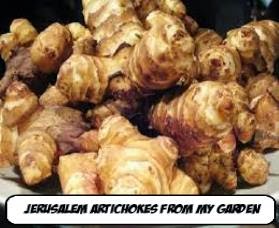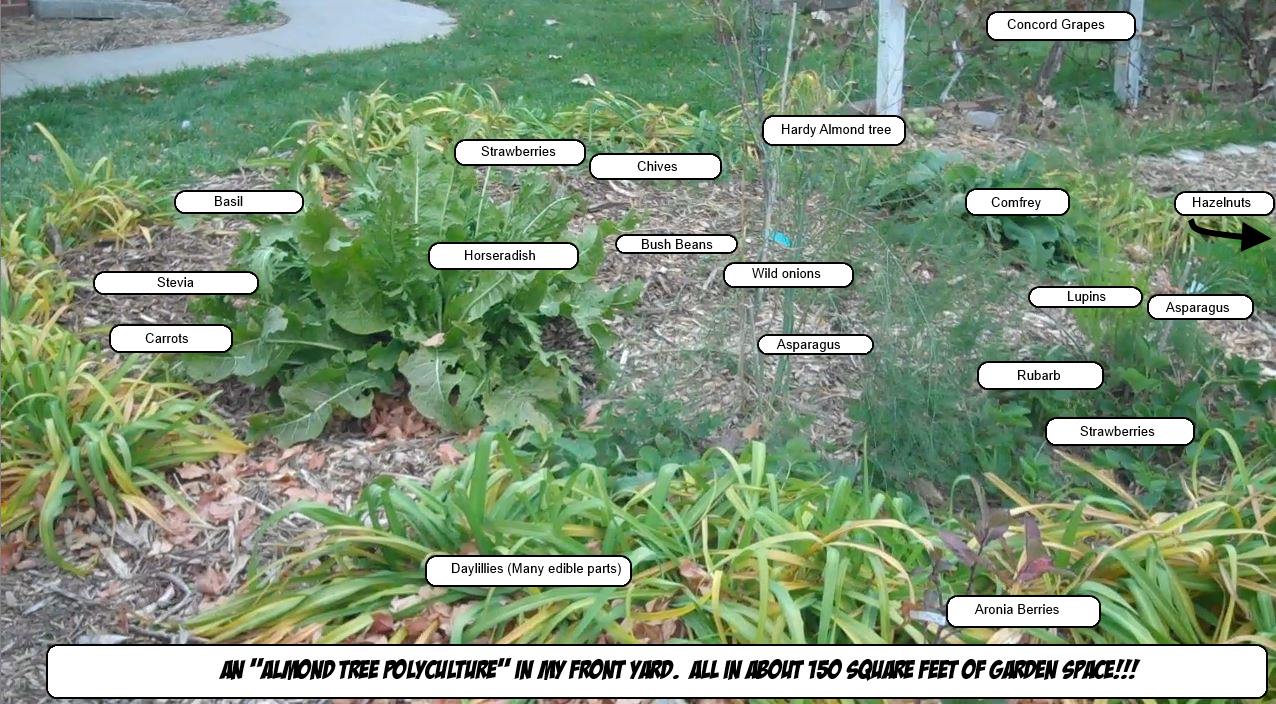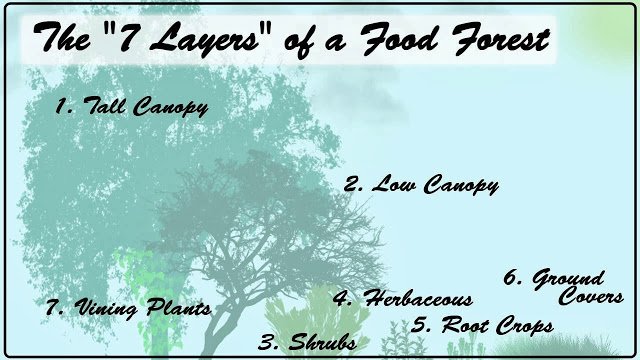Self Sufficiency through a "Permaculture Food Forest"!!!!
Imagine setting aside an area of your Homestead, that's full of hundreds of different kinds of food producing, and medicinal plants that grow all on their own. You don't have to till it, you don't have to weed it, no watering, or planting... All you have to do is harvest, and enjoy!!!
Farming, on historic European farms often consisted of "Paddocks" surrounded by what were called "Hedge Rows". A strip of natural wild land surrounding the farmed areas, which provided benefits to the farmers operation that were so diverse, and subtle, that we are only just beginning to understand the scope of them. Here in the US., there were even "Wild fence rows" surrounding the farm fields until quite recently.
With the "Modern" emphasis on mono-culture farming, and the drive to squeeze every penny's worth of profit from the land, many of these natural areas have been cleared in order to plant every square foot possible with "Cash" crops (Something called "Fence row to Fence row farming.") What's interesting is that these natural areas used to flourish without tilling, fertilizer, planting, or any other interventions from farmers. Learning how these areas, and natural forests work... How they grew all on their own, can be a big part of a modern Homesteader's plan to become more self sufficient!!!
How about planting a "Food Forest Hedgerow?
There's something called a "Permaculture Food Forest". It involves learning how to "Tweek" the natural processes in a forest, or even a hedge row around your homestead areas, to produce food for your family. A forest... That's made of trees and plants that produce food!!! You can actually design and plant it so that once planted,you don't have to do anything except harvest tremendous amounts of food and medicinal plants every year. Once established it will grow, all on it's own, without much effort on your part, for decades. If you're concerned about people stealing your food from your fields, this "Food Forest" is can also be camouflaged so that it doesn't look like a garden, or even a food plot.
Do I have your attention yet????
I've actually begun planting just such a natural forest like "Hedge Row" around a half acre of our own little homestead here in Iowa.
I'd already harvested a lot from the area in this picture (On the right) including a pile of tomatoes from three heirloom tomato plants, but you can get a sense of just how much food can be grown in a small space. (A 14 foot diameter circle). When I'm finished, I'll have a border made up of seventeen of these circular "Polycultures" around the outside of my yard. A "Polyculture" is a permaculture gardening term for a grouping of plants that compliment each other. Call it "Companion planting on steroids".
For example, in the photo, you'll notice Comfrey, a fantastic medicinal herb in it's own right. Comfrey is also known as a "Nutrient miner", it has a tap root that can go as deep as fifteen feet! The comfrey plant brings up minerals, and other nutrients from deep underground and stores them in it's leaves. As the leaves later decompose, they release those nutrients into the top soil. I planted annual bush beans among the other plants, because they have the ability to produce nitrogen in their roots, an essential fertilizer for other plans. The strawberries, will eventually create a dense low canopy over the soil shading out any young weeds preventing them from growing. Daylillies, besides actually having edible parts, will attract beneficial predator insects when blooming, to eat the "Bad bugs". Onions deter mice from chewing the bark off of young trees, Lupins attract beneficial insects and also create nitrogen. The list is endless!
The idea here is to look at each plant, understanding how it grows, and make it "Multi-task" as much as possible. Looking at how plants interact with each other in a natural forest, and trying to mimic that interaction with edible plants. In the Forest, there are a multitude of plant layers, all interacting, and supporting each other. Permaculture Food forests usually concentrate on just seven of these layers. When planning my "Food Forest Hedgerow", I tried to look at these seven layers, and plan for the interactions between them.
It also turns out that there are hundreds of perennial edible vegetables!!! With some research, you can plant a forest garden that either re-grows, or re-seeds itself every year. It can be drought resistant, requiring no fertilizer, and literally care for itself.
It's possible to make a Forest Garden fairly attractive, but the more structured it is, the more work it will require. You can also design one so that it's more haphazard, looking like a natural forest. I designed what I planted, to fit in more, so that my neighbors aren't too upset, but if "Food Crime" increases in my area, I can let it go more wild... Hiding in plain site!!! There are very few people indeed, who know how to dig up "Jerusalem Artichokes" for their tasty tubers underground. Hardly anyone will recognize "Good King Henry" as a perennial spinach. No one in my neighborhood will understand how to use the leaves of a "Stevia" plant as a sugar substitute. The list goes on, and on! If you have any space at all I hope you'll do some internet research on "Food Forest Gardens", and consider planting one yourself!!!



Great post. Although also, as opposed to camouflaging, one might like to let people know that it is food as contribution to increasing awareness and knowledge about urban agriculture and food growing and food security etc. Something that struck me as I looked at your photo with the imposed labels was that it would be cool to label plants with little signs with just that in mind. Thanks for the post! Have followed. Steem-on.
@Kate, I've thought about all of that!!!! My ultimate goal is to create an educational center of sorts. I live in Iowa, where nothing is grown, but corn, and soybeans. I would be very excited if I could convince just one or two local farmers, that they can replace that GMO corn with another system. A system that requires no "Inputs" in the form of fertilizers, diesel fuel, or weed killers. It's been shown that "Agroforestry" can produce as much as 3 times the calories as monoculture!!!!
Great. Of course one of the initial hurdles is that conventional farmers may well have very depleted soil following on from all their intensive relentless monocultures, so it would take a while for the soil fauna and organic matter to build up (of course there's ways to accelerate that). So I guess it's a bit hard to transition from one type to the other if you have a family to feed in the meantime, as it won't be 3 times immediately, it takes a while. I wonder what sort of NGO / governmental support programmes there are there?
I wonder would it be possible to get some land to make a model farm? Either donated privately are designated from public land.
Anyway, look forward to seeing some of your future steemit posts about your efforts!!
I have one acre of good soil.
Sounds like you might already have a plan :)
I have the plan..... I need the 20 year old body back lol.
Hmmmm, have a look at the website "workaway", maybe you can host some people to come and help you out with the manual labour in exchange for food and board if you have that capacity.
<3!! Great minds think alike. ;) Love the post.
This is exactly what we are working towards in our Permaculture Orchard. The first year we moved in we planted the fruit trees with the intention of adding more and more as we went. We are battling the deer!
I have some space I'm planning to plant "Permaculture Orchard" style as in Stefan Sobkowiak's methods. They require a little more maintenance, but can be really productive. A lot of our space is surrounded by a 6 foot fence. It won't stop a deer, but maybe it will make the neighbors Azaleas look more tasty :)
This is an excellent idea. We have started her on this homestead. We had one in Canada, along the "fence rows". I am looking forward to when the forest gardens here take over.
information like this is golden sir thanks for sharing :)
I can give you more technical details if you wish Freaky. It's better though if you research for yourself, so you understand the interactions of what you plant. I can always be available for tips, and tricks.
I'll be learning what grows best in my area though it does seem apples,pears and cherry threes grow in many locations :) I'm just scare that in my own research I'll find what seems like real good info only later to realize I've been had or the location or zoning is all wrong :/ but if I don't try at all I'll never learn :) right ? thank you for the offer :D
@originalworks
@OriginalWorks Mention Bot activated by @goathollow. The @OriginalWorks bot has determined this post by @goathollow to be original material and upvoted it!
To call @OriginalWorks, simply reply to any post with @originalworks or !originalworks in your message!
For more information, Click Here!
Great post here with a lot to learn. Re-steered so I can reread again and others to take note. Thanks.🐓🐓
Super!!!! I appreciate it. Don't forget to "Follow." I'll continue to share as I go. If I can find the damned little clippy thingy that holds my camera to my tripod, I'm going to upload a video soon to Dtube showing how to get free trees, from the ones you already have. (Well, almost free. It takes a plastic bottle, some tape, and some peat moss.) Again.... Thanks for resteeming!
Happy to do it. Very good post. Thanks for stopping by. Hope you find the clippers thing soon. Haha🐓🐓
So much information here! Thank you for sharing and explaining.
In some small way, that is exactly what I am attempting to do here too.
I am turning the entire front flower bed (which is half shaded, half full sun and approximately 30ftx4ft) into an herb garden. Have plans to add so many new herbs next season.
This post will really come in handy. Bookmarked!
@goathollow,
This gem of a post was discovered by the @OCD Curation Team!
Reply to this comment if you accept, and are willing to let us share your gem of a post! By accepting this, you have a chance to receive extra rewards and one of your photos in this article may be used on our compilation post!
You can follow @ocd – learn more about the project and see other Gems! We strive for transparency.
Great idea on planting plants that will provide you with food! I tried my green thumb out this season for the first time, and I was able to get a few vegetables to grow from seed! Next year I plan to do something similar to what you are describing, so thanks for the tips!
Please Reply and I will nominate your post to the @OCD curation team for possible extra votes and Steemit exposure! Keep up the great work with your posts!
@ma1neevent, thanks so much for your comment. If you try this start by planting an apple tree. Make it a "Dwarf" tree. Put one or two comfrey plants around it. Comfrey has a really deep tap root (Up to 20 feet or 7 meters.) It 's a "nutrient miner", meaning it will bring up minerals from the deep soil to feed your other plants. You can chop off it's leaves all Summer, and drop them around the other plants to feed them. At the eventual "Drip line" of your Apple tree, (The eventual outside diameter of the tree.) put in a raspberry, or two and maybe a couple of blueberry bushes. There's a tiny wasp that eats "Apple maggot flies". It also likes blueberries, and they will help attract it. Put in some flowering perennials, to help out the honey bees. In Spring, they'll then know where your Apple tree is, and pollinate it. You can slip in a few Asparagus crowns. Their lacy leaf structure makes a good home for a predatory insect called the Tacinid fly. Tacinid flies eat lots of bad bugs. You might also put in a few "Lupins" They're a pretty perennial flower that makes nitrogen in the soil for your other plants. Fill in the rest of the area with some culinary and medicinal herbs. Echinacea is a good one. Lots of medicinal uses. Finish off by planting a few "Wild onions" around the base of your tree. Mice and voles hate the smell of onions, and garlic. It will keep them from eating the bark off of your baby tree. After the tree gets a little bigger, you can put a grape vine by it, and let the tree act as a trellis for the vine. (Hey what do you know, you said make a reply, and here I wrote a blog lol.... Guess I'll have to post it LOL.)
Haha yes for sure @goathollow! So you don't mind if I share your post with @OCD?
Absolutely!!!
Btw; https://steemit.com/gardening/@goathollow/what-the-heck-is-a-permaculture-polyculture
Wonderful! Thank you so much for all of the great information! Nominated your post to the ocd curators today, be watching @ocd tomorrow to see if you're featured!